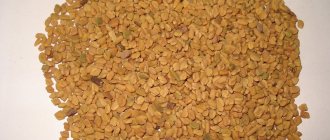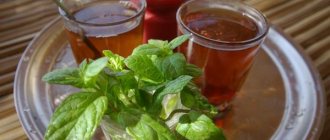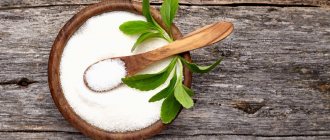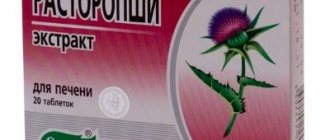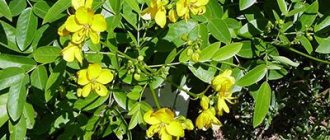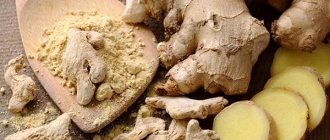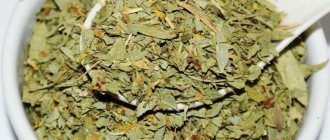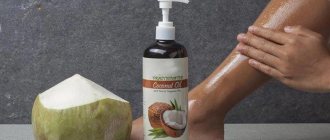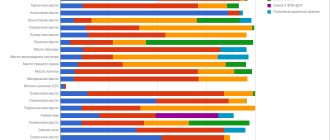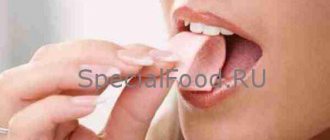What is Helba
The name “yellow tea” may make one think of Chinese yellow teas, but such a comparison is fundamentally incorrect. In fact, this drink is not tea, since its source is not tea leaves, but the fruits of a plant called Helba. In our country this crop is known as fenugreek, and in other countries it is called fenugreek or shambhala. Helba originally grew in Tibet, but today it is grown in Africa, India, Southern Europe and the Caucasus.
Helba is an annual plant that reaches a height of 40-70 cm and has yellow inflorescences. The fruits are shaped like flat cylindrical beans and have a delicate nutty aroma. It is from the fruits that tea is prepared; they are also used as a spice and for various medicinal purposes.
Chemical composition and description of the helba plant
Helba (fenugreek, hilba, fenugreek, shamballa, Greek clover) is a plant of the legume family, 40-70 cm tall. Helba fruits are irregularly shaped pods of 5-10 pieces each.
Asia Minor is considered the birthplace of helba grass; its distribution area is currently wide: from Iran to Europe. Surely you have heard about yellow Egyptian tea. The Egyptians used it long before our era. Now these unique grains are available to everyone. Moreover, they are able to cure some diseases without the use of medication. Yellow hilba grains are a storehouse of vitamins and microelements. It is the chemical composition that makes Helba such a versatile and useful plant.
Minerals (mg):
- potassium - 770;
- calcium - 176;
- magnesium - 191;
- iron - 33.5;
- phosphorus - 296;
- sodium - 67;
- zinc - 2.5;
Vitamins (mg):
- C - 3;
- B1 - 0.32;
- B2 - 0.3;
- B9 (folacin, folin, folic acid) - 57;
- RR - 1.6.
Nutrient content in helba seeds (per 100 grams):
- Fats - 6.4;
- Proteins - 23;
- Carbohydrates - 58.4, including fiber - 10;
Energy value: 328 kcal.
History of Egyptian Helba tea
Fenugreek has long been known as a medicinal plant. A detailed description of its healing properties is found in the works of Hippocrates, Avicenna and Chinese healers. However, it was the Egyptians who figured out how to prepare a tasty and healthy drink from Shambhala.
Nowadays, Helba is rightfully considered the national Egyptian tea, which is often offered to tourists and guests of the country of the pyramids. To prepare a high-quality drink, fenugreek fruits approximately 10 cm long are used. Seeds are extracted from them, and those that reach a diameter of 5 mm are used for tea.
What is Egyptian yellow tea?
In fact, calling Helba tea is not entirely correct, since it is prepared not from tea leaves, but from fenugreek seeds. This is a common plant that grows naturally not only in Egypt, but also in many other countries. Therefore, it goes by many names: shambhala, chaman, camel grass, hilba, Greek goat trefoil, helba, blue clover, Greek fenugreek, cocked hat, fenugreek and fenugreek. Fenugreek has been used for medicinal purposes since time immemorial by many peoples, but the idea of preparing a tasty and tonic drink from it belongs to the Egyptians; therefore, it is considered national and is treated to all tourists and visitors.
Composition (including chemical)
Helbe contains a huge number of different useful elements that are necessary for the prevention and treatment of all kinds of diseases. Fenugreek seeds contain elements such as flavonoids, polysaccharides, essential oils, vitamins of all groups, mucous and nitrogenous substances. Microelements include magnesium, potassium, selenium, zinc, calcium and iron.
If we consider the composition of BZHU (proteins, fats, carbohydrates), then 100 g of helba seeds contains:
- 10 g fiber;
- 23 grams of proteins;
- 59 grams of healthy carbohydrates;
- 6.5 grams of fat.
Calorie content is 323 kcal per 100 g.
Indications for use
Modern medicine recommends a fenugreek drink in the following cases:
- Inflammatory processes in the stomach and duodenum (gastritis, duodenitis). Thanks to starch and tannins, which are part of helba seeds, tea coats the walls of the stomach. Thus, the aggressive environment of digestive juice and consumed food does not irritate the stomach, creating conditions for inflammation to subside;
- Diseases of the ovaries and mammary glands in women. The plant hormone contained in Shambhala promotes the resorption of cysts in the gonads and breasts. On any day of the cycle, except menstruation, tea is very useful, especially for women after forty. Their production of their hormones slows down, Shambhala replenishes the body with a natural hormone;
- Chronic diseases of the lungs and bronchi. Helba tea helps the natural discharge of sputum and the rapid restoration of the mucous membrane;
- Heat. Children can be given yellow tea as a mild antipyretic for viral diseases;
- Lactation period. In nursing mothers, helba tea promotes normal breast milk production;
- Diseases of the genitourinary system. The herb helps flush sand from the kidneys and prevents the formation of stones. It is recommended to drink yellow tea for cystitis, as it has antibacterial properties;
- Stress, nervous tension, sleep disturbance. Egyptian helba tea has a mild sedative (calming) effect on the central nervous system.
Yellow tea
Benefits and harms
Such a rich composition determines the huge number of beneficial properties of Helba tea. Studies have shown that drinking tea really helps in the prevention and treatment of many diseases. However, do not forget that Helba has some contraindications.
In this video we will talk about Helba (Fenugreek) as a cure for 100 diseases, its composition and beneficial properties.
Useful properties and indications for use
Egyptian yellow Helba tea perfectly strengthens the body and improves immunity. Its tonic, anti-inflammatory and antispasmodic properties are well known. Fenugreek can lower the temperature, so it should be taken for colds and ARVI.
In addition, Helba tea affects the body as follows:
- Combats problems of the genitourinary system. Fenugreek can relieve inflammation, and when taken regularly, it removes sand and stones from the kidneys.
- Normalizes the functioning of the gastrointestinal tract. The substances contained in the infusion protect the gastric mucosa from spicy foods and alcohol. With long-term use, it is possible to get rid of stomach ulcers and restore acid balance.
- Lowers blood sugar levels. This property is especially useful for diabetics.
- As already mentioned, it treats colds. Lowers temperature and helps remove mucus from the lungs.
- It is successfully used for diseases of the female reproductive system. Helba contains substances that resemble female hormones in their action, and therefore can restore hormonal levels and help in the treatment of infertility.
- Normalizes blood pressure. Yellow tea successfully fights cholesterol plaques in blood vessels and is useful for hypertensive patients.
- Increases male potency.
In addition, regular consumption of Helba tea can increase concentration and overall performance, as well as relieve stress and reduce depression.
Contraindications
It is strictly forbidden to drink Helba tea during pregnancy, since the substance diosgenin it contains can increase the tone of the uterus and lead to bleeding or even miscarriage.
People with chronic bleeding should not drink tea (or in this case, consume it in small portions). It is recommended to exercise caution if you have diabetes, thyroid dysfunction, or taking medications that prevent the formation of blood clots. People with gastrointestinal diseases should first consult a doctor, as Helba can cause nausea, vomiting and diarrhea.
In general, you should not drink excessive amounts of tea, as an overdose can cause allergies, dizziness, or stomach upset. Also, avoid drinking yellow tea before bed as it can cause insomnia.
Any unpleasant or undesirable symptoms indicate that the use of Helba should be stopped.
Can men drink or not?
It is believed that Helba tea should be consumed specifically by women, since it contains components very similar to female sex hormones. However, it is no less useful for men to drink this tea, since it can help with impotence and improve the functioning of the prostate gland.
Useful properties of Helba
You can write a lot and for a very long time about all the benefits of fenugreek and, accordingly, tea based on it. But since we are now not on an encyclopedic resource or on a site about the medicinal plants of our planet, the circle of interests is narrowing. So let's talk about what Helba's help for weight loss is.
Recently, there have often been notes on the Internet that this spice can be used to prepare your own “weight loss” drink. It is said that Shambhala allegedly accelerates metabolic processes in the body several times and even eliminates fat deposits. This is wrong. For those losing weight, Helba is useful only from the point of view of the mild laxative and diuretic effect that this tea can have.
In addition, the rich fiber content (fenugreek seeds contain even more dietary fiber than spinach and green salad) and the tart taste of the drink allow you to quickly feel full. This is a good prevention of overeating - the “scourge” of many overweight people. So Egyptian yellow tea, “curry”, and “khmeli-suneli” are just what the “doctor ordered” for adapting to a new diet, which implies unusually strict restrictions on portion sizes and calories.
Ideally, Helba for weight loss should be used on an empty stomach. After drinking this tea, it is advisable not to eat for 1-2 hours.
How to brew yellow tea
When brewing Helba, the usual method is not suitable, since fruits are used to obtain tea, not leaves. Cooking is necessary to open them and saturate the infusion with useful substances.
Classic recipe
If you have fenugreek beans at your disposal, you should wash and dry them, then remove the fruits, fry them and chop them. If you have ready-made fried Helba seeds, then you can proceed to the next step:
- Pour 1 tsp into a small container. ground fruits and pour a glass of water.
- Place the saucepan on low heat and cook the infusion for 10 minutes.
- The finished tea should be strained.
To improve the taste, you can add honey or various spices to the drink, such as ginger and cinnamon. It is worth saying that many people distinguish notes of cheese or mushrooms in the spicy aroma of tea.
To get the maximum amount of benefits from tea, Helba seeds can first be soaked for a couple of hours and then boiled in the usual way in the same water.
For a sore throat
To get rid of a sore throat, you should prepare a rich infusion of Helba. 2 tbsp. l. seeds, pour 0.5 liters of boiling water and cook for half an hour over low heat. The prepared decoction is used to gargle a sore throat. After several procedures, noticeable relief from pain and soreness is felt.
For bronchitis
To remove mucus from the bronchi, you need to use a mixture of herbs: take 1 tsp. fenugreek, elderberry, fennel seeds and 2 tsp. tricolor violets, linden blossom. This mixture is poured into a glass of cold water (200 ml). The herbs are infused for about 2 hours and then boiled for 5 minutes. The finished tea is filtered and drunk warm throughout the day.
For the treatment and prevention of kidney disease
Take 5 tsp. Helba seeds and 3 dates, pour a glass of water (200 ml), then cook over low heat for about 7 minutes. The decoction should be drunk three times a day in 100 ml portions. The drink helps remove sand from the kidneys and crush small stones.
To cleanse the intestines
For 2 tsp. seeds, take a glass of water, pour in and cook for 5 minutes. To improve the taste of tea, you can add figs and honey. To effectively remove waste and toxins, drink the decoction in small quantities before each meal.
Other healthy recipes
Fenugreek is used for more than just tea. It is also used in cosmetology. Oil from the seeds of the plant promotes skin regeneration and relieves inflammation. It is used to treat areas affected by psoriasis, which eliminates severe symptoms.
Hair Mask
Fenugreek has proven to be an indispensable source of nutrients for hair. Helba seed masks help strengthen hair and prevent hair loss.
- Grind the fenugreek seeds and mix in equal proportions with ground cumin and olive oil;
- Rub the mask into the skin at the roots of the hair, put a plastic bag on your head to create a greenhouse effect;
- Keep the mixture on your head for 20-30 minutes;
- Rinse with warm water and dry naturally.
This mask not only strengthens hair, but also effectively gets rid of dandruff. People suffering from scalp dermatitis will find it very useful to apply this paste to the affected areas.
Mask for the face
You can also make a rejuvenating face mask using helba seeds:
- Grind the seeds, mix with honey, cumin and olive oil in equal proportions. Add chicken egg yolk;
- Apply the mask to the face with light massage movements;
- Rinse off with warm water after 15-20 minutes.
For dry skin, this mask provides a nourishing effect. Regular implementation of such procedures will prolong the youth of the skin and prevent the early appearance of facial wrinkles.
For those who are too lazy to cook according to the recipe, you can add the tea leaves left after drinking tea to a store-bought mask and apply it to your face. The effect will not be so pronounced, but such a mask is also beneficial for the skin.
Helba in a spoon
How to drink (frequency, quantity)
Egyptian yellow Helba tea is a rather unusual drink, not similar to ordinary teas, and therefore should be drunk in moderation, not in glasses. One cup a day is enough to get all the beneficial elements.
You can drink tea either hot or chilled, as it quenches thirst equally well in hot weather and warms you in cold weather. High-quality and properly prepared Helba tea has a rich yellow color and a nutty taste with some bitterness. To improve and diversify the taste, you can add citrus fruits, turmeric, mint, figs, raspberries, and dates. In addition, fenugreek decoction can be mixed with regular green or black tea, or prepared with milk.
Contraindications to the use of fenugreek
With moderate consumption of Helba tea, it brings a lot of benefits to the body, but excessive consumption (more than 3 cups daily) can be harmful. In addition, drinking this drink is not recommended in the following cases:
- individual intolerance;
- tendency to allergic reactions;
- during pregnancy causes uterine tone;
- diabetes;
- bronchial asthma;
- neoplasms in the mammary glands;
- increased blood clotting;
- taking medications;
- increased levels of hormones (prolactin and estrogen);
- children under 7 years old.
For medicinal purposes, the use of fenugreek decoction should be carried out in courses lasting no more than 6 weeks, with a break of 2 weeks.
Storage and shelf life
As a rule, seeds remain usable for a year if storage conditions are followed. They should be protected from moisture and direct sunlight. In addition, Helba can easily absorb foreign odors, so it is worth placing its fruits in an airtight container.
Old seeds are well distinguished by color: fresh fruits have a bright mustard color, but darken over time. You can distinguish low-quality tea by taste, since the decoction of old fruits is very bitter.
History of appearance
From this article you will learn:
Egypt is one of the oldest countries in the world. Here there is a place for magnificent sunny beaches, monumental pyramids and unusual yellow tea - helba. Since time immemorial, the local population not only knew about its existence, but also highly valued its positive properties.
Hippocrates used the drink to treat most gynecological diseases. It has been established that fenugreek (the base of tea) can relieve discomfort during the menstrual cycle.
Helba tea leaves were used as tinctures, infusions, medicines, ground powder and food additives. The drink was also known under other names - abish, helba, fenugreek, chaman, shambhala, camel grass. The recipe for brewing it has not actually changed, despite the fact that several centuries have passed since then.
Where to buy and how much it costs
You can buy Helba yellow tea directly in Egypt if you are going there on vacation. In Russia, its seeds or fruits can be found in oriental spice or health food stores. It is also offered for purchase in various online stores.
The price depends on the condition of the fenugreek fruit. Unprocessed fruits cost an average of 100 rubles per 100 grams, while washed and crushed seeds, which can be directly brewed, are sold slightly more expensive, their cost will be 2-2.5 times higher.
Fenugreek seed tea
Helba tea is a yellow tea made from fenugreek seeds. This drink is most popular in Egypt (hence the name), although the plant grows almost all over the world. Tea has a rather specific taste and aroma; after trying it for the first time, you can conclude that it is not a particularly pleasant drink. Gradually this feeling disappears and you can get real pleasure from drinking. The main value of tea lies not only in its original taste, but also in its health benefits. Tea contains a huge amount of beneficial substances that help maintain health and cope with various diseases.
Reviews
As an example, here are a few reviews left by real visitors to our site through the comment form for this article:
Review from Olga: Recently I was treated to an amazing drink - Egyptian yellow tea. When brewing, instead of the usual loose leaf tea, I saw something incomprehensible, similar to an unknown cereal.
The finished drink is slightly sweet. The smell is unusual, but pleasant: ginger, nutmeg, and unexpectedly a mixture of khmeli-suneli seasonings. To improve the taste, you can add honey, lemon and cinnamon to your tea.
Review from fialka36: Once we were on vacation in Egypt, where we were advised to buy Egyptian yellow tea - Helba, which is considered a cure for all diseases there. Of course, I was interested in it, and I bought it. But when I brewed it at home and tried it for the first time, I didn’t like the taste at all, it was so spicy, it wasn’t for everyone.
Despite this, I began to drink it further, getting used to the taste. After some time, I noticed that my immunity had significantly increased, and colds had practically disappeared.
Egyptian yellow Helba tea is an amazing drink with an interesting taste and many healing properties. It is incorrect to call it tea, since the fruits need to be boiled, but this is not so important. The real value is the beneficial elements contained in this plant that can fight many diseases.
Benefits for women
The beneficial properties for women are revealed especially clearly in helba. The female hormonal system is most susceptible to deviations from the norm, unlike the male one, and Egyptian tea is that “magic” regulator. How can consuming hilba help women?
Helba for infertility
Infertility is usually a consequence of some inflammatory processes in the pelvic organs. The antiseptic and anti-inflammatory effect of hilba decoction improves blood circulation while simultaneously affecting tumor sites. Thus, regular consumption of yellow tea for 2-3 months can bring the long-awaited joy of conception.
Helba for menstrual irregularities and painful PMS
Helba seeds can and should be successfully used in gynecology. Simply because treatment with their help shows excellent results. If you dig deeper, the reason lies in the chemical composition. A substance such as diosgenin, related to progesterone, stimulates the synthesis of female steroid hormones corticosteroids and estrogen at the right time. For this reason, hormonal levels become balanced.
Helba in the treatment of infectious diseases of the reproductive system
For women, yellow tea will be very useful in the treatment of such unpleasant genital diseases caused by microorganisms as uterine fibroids, inflammation of the vagina and vulva, as well as polycystic ovary syndrome.
The method of application is simple: you need to syringe the affected pelvis with a strong infusion of a freshly prepared drink at the rate of 1-2 tablespoons per glass of boiling water.
Also, for the treatment of infectious diseases of the reproductive system, in particular inflammation of the uterus, vagina and vulva, you can use douching with an infusion of the drink (1-2 tablespoons per glass of boiling water).
Helba to increase lactation and growth of mammary glands
If you are a nursing mother, then Hilba will become just a lifesaver. One of the main properties of the drink is a significant stimulation of lactation. You don't have to buy artificial formula; breast milk will be more than enough. This is not an unfounded statement. Studies were conducted at an Indian university confirming the fact of breast growth in women. The natural analogue of prolactin included in the plant increases lactation by more than 30-50%.
Directions for use: a tablespoon of seeds per 200 ml of boiling water 2-3 times a day.
In addition to increased milk production, women will definitely appreciate the long-term cosmetological effect of Egyptian Hilba tea to create a chic bust.
Helba for weight loss
Losing excess weight nowadays resembles some kind of race. In this pursuit of a slim body, women do not skimp on anything, but few people realize that a good figure is achieved mostly through proper nutrition. Yellow tea serves its function as a dietary supplement to reduce appetite. Helba affects the saturation centers, you want to eat much less.
Additionally, the powerful effect of cleansing the body of polyps, waste and toxins greatly complements proper nutrition and makes it difficult to re-deposit fat.
How to brew helba for weight loss?
Place 2 teaspoons of washed seeds in a container and add 200 ml of clean water. Then bring to a boil and cook for 1-2 minutes over low heat. After this, the tea should still steep for about 5 minutes. It is advisable to take it warm; you can add honey, cinnamon or ginger to taste. In addition to a balanced diet, you should drink a couple of cups of this decoction a day.
Helba for face and hair
Hilba was also used for cosmetic purposes in Egypt. Face masks based on a paste of ground seeds served as an elixir of youth for ancient Egyptian women.
What do you get by making a face mask:
- get rid of skin inflammation, acne, dermatitis;
- the face will acquire a healthy color, bags under the eyes will disappear;
- warts will resolve.
If you apply the paste to your hair along with vegetable oil, it will quickly help get rid of dandruff.
We recommend you see how to use helba to make your hair chic without any chemicals.
Helba and cosmetology
Teas have long been used in cosmetology; they are used to make masks not only for the skin, but also for the hair. Yellow tea is also loved by those who try to take care of themselves using natural products.
Helba contains many vitamins, minerals and amino acids, which are simply necessary for healthy and youthful skin and hair.
The polyphenols contained in the raw materials give the procedure an aromatherapy effect, which relieves stress, fatigue, calms not only the nerves, but also the skin, making it look younger! Polyphenols relieve irritation, this is especially important in case of allergies, harmful working conditions and living in a dusty city.
Helba cookies
For syrup: one glass of water, one glass of sugar, one tablespoon of lemon juice.
For the decoction: one glass of water, one dessert spoon of fenugreek seeds (helba).
For the dough: two cups of semolina, half a cup or a little more ground walnuts, half a cup of olive oil, one tablespoon of sugar, a third of a teaspoon each of cinnamon and turmeric, salt, two tablespoons of vegetable oil.
Cook the syrup. Boil a glass of water. When it boils, add a glass of sugar and stir until dissolved. Add lemon juice and cook for five minutes over low heat.
Make a decoction of Helba tea like regular tea, cook for about five minutes.
Prepare the dough. Mix semolina, sugar, walnuts, cinnamon, turmeric, salt, add olive oil, continue stirring. Then add the broth. You need enough of it to make a dough of medium consistency and elastic. A little broth may remain.
Grease the mold with vegetable oil and place the dough in it in a layer no more than one cm thick. Grease the top of the cake with vegetable oil.
Directly in the mold, cut the cake into small portions into diamonds, squares, and any shapes. It is better to do this with a special knife so as not to spoil the shape.
For beauty, each piece can be decorated with an almond or half a walnut, lightly pressing it into the dough.
The oven should already be preheated. Bake cookies over low heat for 40-45 minutes. Its readiness will be visible by its golden brown color.
Without touching the finished cookies, fill them with syrup and leave them for several hours or overnight.
